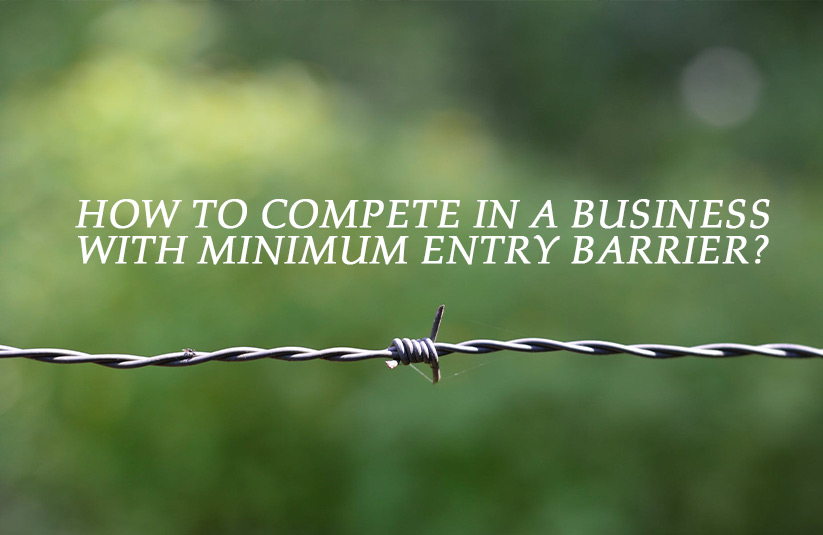How to Compete in a Business with a Minimum Entry Barrier? Some techniques will help you prosper in a low-barrier-to-entry competitive landscape.
What are Barriers to Entry?
Barriers to entry are the hindrances or obstacles that make it difficult for startups or businesses to enter the market. These barriers may include patents, technology challenges, government regulations, education, start-up costs, or licensing requirements. Barriers to entry are said to be an important consideration for entrepreneurs who are entering a market.
Some barriers to entry actually exist due to government intervention and the rest of them happen naturally within a free market. It helps in protecting the integrity of an industry and also prevents new entrants from launching inferior products into the market. Every industry will have a specific set of barriers to entry which has to be dealt with by the startups.
Some Points to Note
- Scientific, professional, and technical services are the field that has the lowest overall barriers to entry which is then followed by construction and retail trade
- Industries with high barriers to entry include Forestry, agriculture, hunting, and fishing, followed by warehousing and transportation and then wholesale trade
- Rental and leasing businesses and Real estate can operate with no employees in the early stage, so they will be able to avoid barriers to entry that are related to hiring
- Legal barriers to entry may involve Government red tape which is considered to be a concern in warehousing and transportation, followed by construction. It has less impact on Retail trade companies
- Natural barriers to entry mostly occur in monopolistic markets where the entry cost to the market may be very high for new firms
How do Overcome Entry Barriers in the Market?
Incontestable markets, both the entry & exit barriers are said to be below that which creates a situation where potential & actual competitive pressures are high. Let us now see how to overcome some of the traditional entry barriers.
- Start with a minimum feasible product and then repeat based on the feedback of your consumers
- Have different objectives & use a disruptive pricing model
- Produce outstanding products so that it makes it less price-sensitive
- Upscale an existing brand in order to enter a new market which will be an economy of scope
- Viral marketing can help to cut the marketing costs involved in attracting new sales
- Acquire a business that is already established in the market
- Reduce fixed costs by leasing instead of buying equipment or retail space
- Use high research intensity to out-innovate the already existing firms
- Cut costs by using open-source instead of proprietary software
- Flexible & lean manufacturing/supply on demand
- Use YouTube or Amazon Market place as your sales platform. It could give you a free ride on scaled channels
- Accept the losses that incur initially; this helps you play the long game
1. Red Tape
For many new entrepreneurs, one of the biggest challenges is dealing with the government. Whether it is complying with regulations or finding out complicated tax codes, Government red tape can give certain hurdles for new entrants who may lack the experience or resources when compared to their established competitors.
2. Competition
The basic fact for any startup is to compete with other businesses. Entrepreneurs may need a leaner, smarter, or just simple approach which should be different from their competitors in order to succeed. But stable networks of customers, economies of scale, and other factors may give an advantage to more established players that hold a significant place over others in the industry.
3. Startup Costs
The first problem for any new owners will be the startup costs. It is considered to be a highly variable factor from industry to industry. Some businesses may require a little investment while other businesses may demand a major investment.
Employment challenges: Most of the barriers to entry for new businesses may actually revolve around employment. Managing employees, hiring, and firing may involve learning complicated regulations. For example, certain businesses may require training for their employees for a specific process. So a business without employees will actually have lower barriers to entry.
Read Here: What Is More Important for A Successful Startup?
Conclusion:
In conclusion, mastering the art of differentiation and leveraging niche opportunities are key strategies to excel in a business with a minimum entry barrier. By implementing these approaches effectively, you can carve out your place in the market and achieve sustainable success. How to Compete in a Business with a Minimum Entry Barrier? It’s all about finding your unique angle and capitalizing on it.
FAQs
How can a business overcome barriers to entry?
Business owners can overcome barriers to entry by introducing feasible products initially and then based on the customer feedback one can proceed.
What are the 7 examples of barriers to entry?
The 7 examples of barriers to entry include Government policy, Switching costs, Economies of scale, Capital requirements, Product differentiation, Access to distribution channels, and cost disadvantages independent of scale.
What are your competitive strategies to create barriers to entry?
Some of the competitive strategies to create barriers to entry are brand networks, customer involvement, Investment, ongoing innovation, self-expressive benefits, execution, scale, proprietary technology, etc.
What happens when barriers to entry are low?
Markets which has low entry barriers may actually have many players. Thereby, the profit margins will be low.













